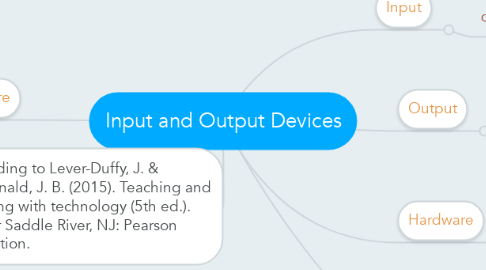
1. Software
1.1. "Sets of computer instructions written in computer languages that tell a computer how to function".
1.1.1. Example: Applications or apps on mobile devices.
1.1.2. Benefits: This is how the computer learns to complete a task, the computer has to follow the instruction of the software. Challenges: The computer has to be up to date with all current functions.
2. According to Lever-Duffy, J. & McDonald, J. B. (2015). Teaching and learning with technology (5th ed.). Upper Saddle River, NJ: Pearson Education.
3. Input
3.1. "Is any device that allows users to enter data and commands".
3.1.1. Example: The keyboard and pointing devices, such as a trackball, joystick, touch pad, fmouse, and a stylus.
3.1.1.1. Gestures and voice recognition
3.1.1.2. Benefits: It allows user toimput the information for what they may be needing information. Challenges: The information may or may not be up to date. Incorrect information
4. Output
4.1. "Devices create hard and soft copies via displays and printers".
4.1.1. Example: The monitor and the printer.
4.1.1.1. Gestures and voice recognition.
4.1.1.2. Benefits: Gve hard copies of all information input in the computer. Challenges: Maybe faced with system probms.
5. Hardware
5.1. "Enables input into the computer, processing of raw data into final form, and the output of information".
5.1.1. Example: Operating Systems and computer memeoary and hard drive and flash drive.
5.1.1.1. Benefits: This allows indivduals to work the computer. This is the major part of the computer, it allows you to complete all task. Challenges: Not working or uable to use the devices.
